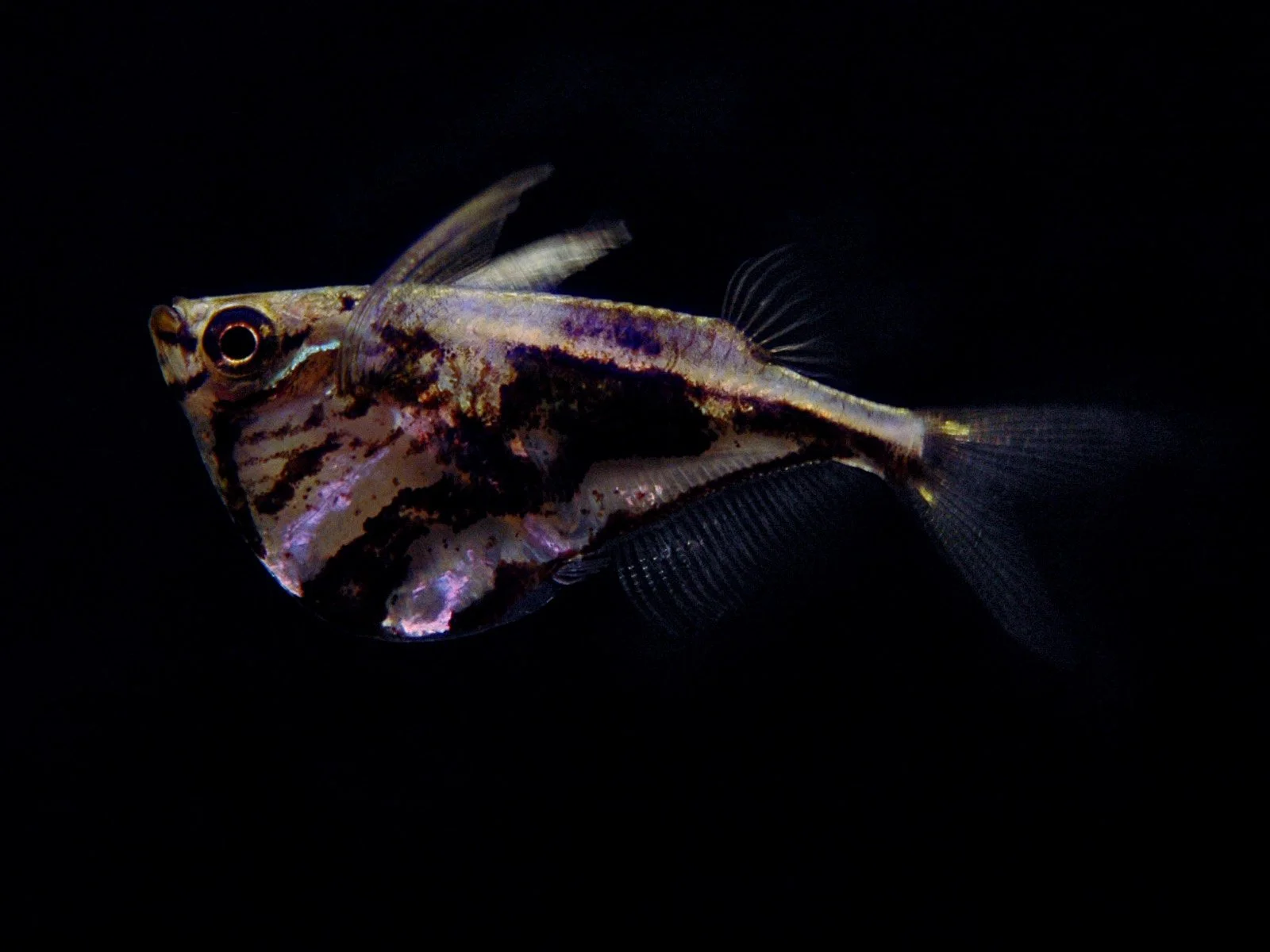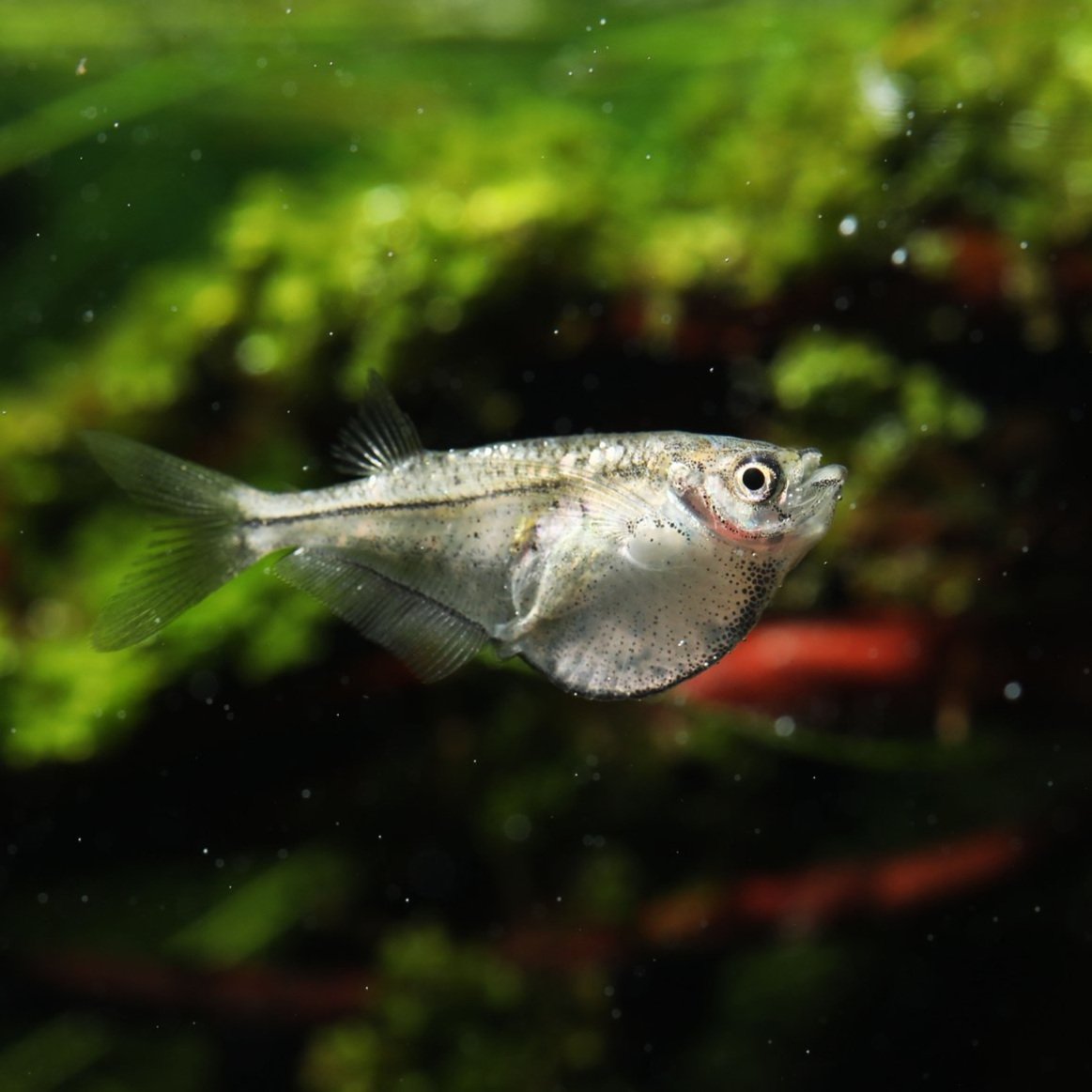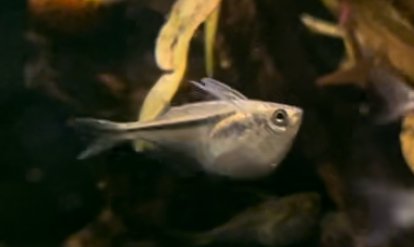 Image 1 of 3
Image 1 of 3

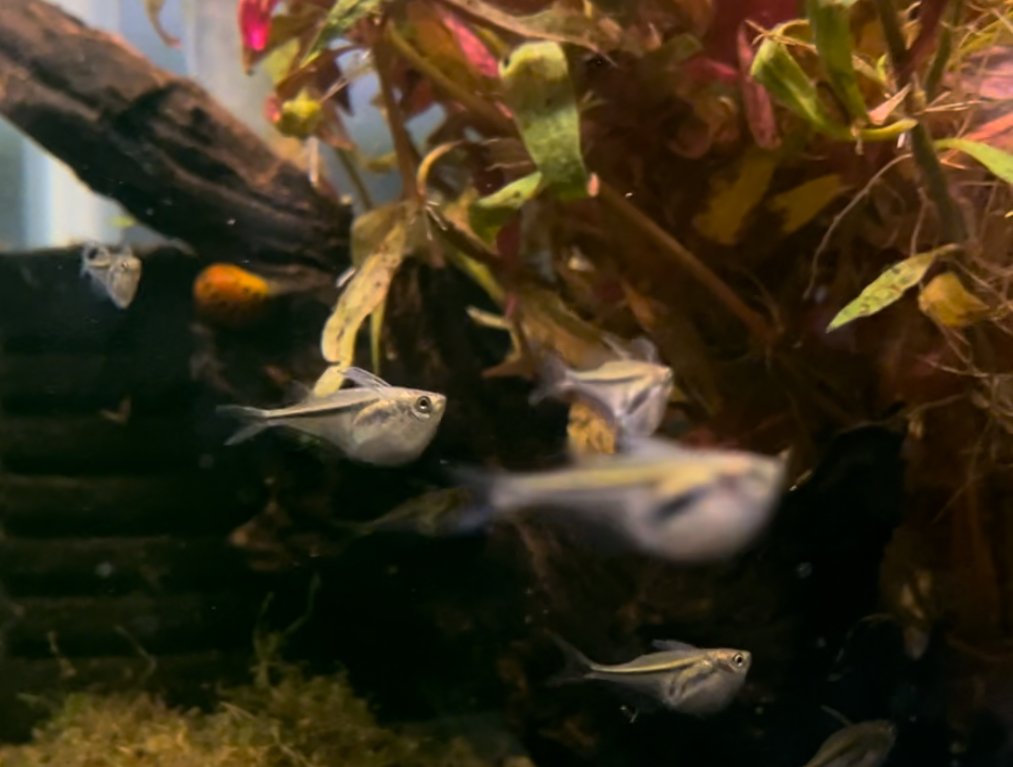 Image 2 of 3
Image 2 of 3

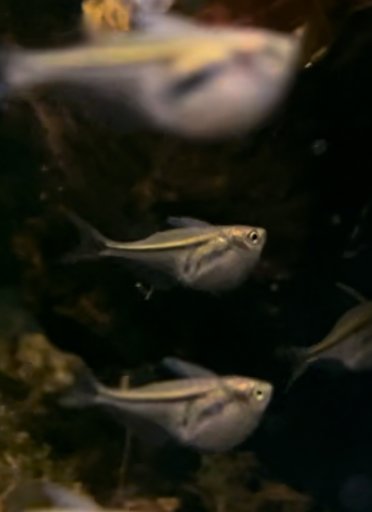 Image 3 of 3
Image 3 of 3




Marthae Hatchetfish
The Marthae Hatchetfish, scientifically known as Carnegiella marthae, is a unique and elegant freshwater fish species that is highly valued by aquarists for its distinctive shape, subtle coloration, and fascinating behavior. Native to the slow-moving streams and rivers of the Amazon Basin in South America, this small, surface-dwelling fish brings a touch of the exotic to well-planted aquariums.
Physically, the Marthae Hatchetfish is instantly recognizable by its distinctive hatchet-shaped body, which is deep and laterally compressed, resembling the blade of a hatchet. This body shape is adapted for surface-dwelling, allowing the fish to glide effortlessly near the water’s surface. The Marthae Hatchetfish is characterized by its silvery body with a delicate, translucent sheen, sometimes showing faint hints of green or blue under the right lighting conditions. Unlike some of its relatives, it lacks the prominent marbled pattern but instead has a more subtle, elegant appearance. Mature specimens typically reach lengths of around 1 to 1.5 inches (2.5 to 4 centimeters), making them suitable for nano and medium-sized aquariums.
In aquariums, Marthae Hatchetfish thrive in well-planted tanks with plenty of surface cover. Floating plants, such as water lettuce, duckweed, or frogbit, are particularly beneficial as they provide shade and a sense of security, helping the fish feel more comfortable and reducing stress. These fish are surface dwellers and spend most of their time near the water’s surface, so it’s essential to have a tightly fitting lid on the aquarium, as they are known for their ability to jump out of the water when startled.
Water parameters for Marthae Hatchetfish should closely mimic their natural habitat. They prefer slightly acidic to neutral water with a pH range of 5.5 to 7.0 and temperatures between 75 to 82°F (24 to 28°C). These fish are sensitive to fluctuations in water quality, so maintaining stable, clean water with regular water changes and efficient filtration is crucial for their well-being.
Feeding Marthae Hatchetfish is relatively straightforward, as they are primarily surface feeders with a preference for small, floating foods. In the wild, they feed on insects and small invertebrates that fall onto the water’s surface. In captivity, they will readily accept high-quality floating flakes, micro-pellets, and freeze-dried or live foods such as bloodworms, daphnia, and brine shrimp. Offering live or frozen foods regularly can help maintain their health and encourage natural feeding behaviors.
Breeding Marthae Hatchetfish in captivity is challenging due to their specific requirements and delicate nature. If breeding is attempted, a separate breeding tank with soft, acidic water and dense floating plants or fine-leaved vegetation is recommended. The fish typically scatter their eggs among the plants, and the eggs hatch within a few days. The fry are very small and require microscopic foods like infusoria or freshly hatched brine shrimp until they are large enough to consume larger foods.
Overall, the Marthae Hatchetfish (*Carnegiella marthae*) is a graceful and captivating addition to freshwater aquariums, prized for its unique shape, subtle beauty, and peaceful nature. With proper care and attention to their specific needs, these fascinating fish can thrive and bring a touch of the Amazon’s mystery and elegance to aquarists of all levels of experience, enhancing the diversity and appeal of any aquatic environment.
The Marthae Hatchetfish, scientifically known as Carnegiella marthae, is a unique and elegant freshwater fish species that is highly valued by aquarists for its distinctive shape, subtle coloration, and fascinating behavior. Native to the slow-moving streams and rivers of the Amazon Basin in South America, this small, surface-dwelling fish brings a touch of the exotic to well-planted aquariums.
Physically, the Marthae Hatchetfish is instantly recognizable by its distinctive hatchet-shaped body, which is deep and laterally compressed, resembling the blade of a hatchet. This body shape is adapted for surface-dwelling, allowing the fish to glide effortlessly near the water’s surface. The Marthae Hatchetfish is characterized by its silvery body with a delicate, translucent sheen, sometimes showing faint hints of green or blue under the right lighting conditions. Unlike some of its relatives, it lacks the prominent marbled pattern but instead has a more subtle, elegant appearance. Mature specimens typically reach lengths of around 1 to 1.5 inches (2.5 to 4 centimeters), making them suitable for nano and medium-sized aquariums.
In aquariums, Marthae Hatchetfish thrive in well-planted tanks with plenty of surface cover. Floating plants, such as water lettuce, duckweed, or frogbit, are particularly beneficial as they provide shade and a sense of security, helping the fish feel more comfortable and reducing stress. These fish are surface dwellers and spend most of their time near the water’s surface, so it’s essential to have a tightly fitting lid on the aquarium, as they are known for their ability to jump out of the water when startled.
Water parameters for Marthae Hatchetfish should closely mimic their natural habitat. They prefer slightly acidic to neutral water with a pH range of 5.5 to 7.0 and temperatures between 75 to 82°F (24 to 28°C). These fish are sensitive to fluctuations in water quality, so maintaining stable, clean water with regular water changes and efficient filtration is crucial for their well-being.
Feeding Marthae Hatchetfish is relatively straightforward, as they are primarily surface feeders with a preference for small, floating foods. In the wild, they feed on insects and small invertebrates that fall onto the water’s surface. In captivity, they will readily accept high-quality floating flakes, micro-pellets, and freeze-dried or live foods such as bloodworms, daphnia, and brine shrimp. Offering live or frozen foods regularly can help maintain their health and encourage natural feeding behaviors.
Breeding Marthae Hatchetfish in captivity is challenging due to their specific requirements and delicate nature. If breeding is attempted, a separate breeding tank with soft, acidic water and dense floating plants or fine-leaved vegetation is recommended. The fish typically scatter their eggs among the plants, and the eggs hatch within a few days. The fry are very small and require microscopic foods like infusoria or freshly hatched brine shrimp until they are large enough to consume larger foods.
Overall, the Marthae Hatchetfish (*Carnegiella marthae*) is a graceful and captivating addition to freshwater aquariums, prized for its unique shape, subtle beauty, and peaceful nature. With proper care and attention to their specific needs, these fascinating fish can thrive and bring a touch of the Amazon’s mystery and elegance to aquarists of all levels of experience, enhancing the diversity and appeal of any aquatic environment.
The Marthae Hatchetfish, scientifically known as Carnegiella marthae, is a unique and elegant freshwater fish species that is highly valued by aquarists for its distinctive shape, subtle coloration, and fascinating behavior. Native to the slow-moving streams and rivers of the Amazon Basin in South America, this small, surface-dwelling fish brings a touch of the exotic to well-planted aquariums.
Physically, the Marthae Hatchetfish is instantly recognizable by its distinctive hatchet-shaped body, which is deep and laterally compressed, resembling the blade of a hatchet. This body shape is adapted for surface-dwelling, allowing the fish to glide effortlessly near the water’s surface. The Marthae Hatchetfish is characterized by its silvery body with a delicate, translucent sheen, sometimes showing faint hints of green or blue under the right lighting conditions. Unlike some of its relatives, it lacks the prominent marbled pattern but instead has a more subtle, elegant appearance. Mature specimens typically reach lengths of around 1 to 1.5 inches (2.5 to 4 centimeters), making them suitable for nano and medium-sized aquariums.
In aquariums, Marthae Hatchetfish thrive in well-planted tanks with plenty of surface cover. Floating plants, such as water lettuce, duckweed, or frogbit, are particularly beneficial as they provide shade and a sense of security, helping the fish feel more comfortable and reducing stress. These fish are surface dwellers and spend most of their time near the water’s surface, so it’s essential to have a tightly fitting lid on the aquarium, as they are known for their ability to jump out of the water when startled.
Water parameters for Marthae Hatchetfish should closely mimic their natural habitat. They prefer slightly acidic to neutral water with a pH range of 5.5 to 7.0 and temperatures between 75 to 82°F (24 to 28°C). These fish are sensitive to fluctuations in water quality, so maintaining stable, clean water with regular water changes and efficient filtration is crucial for their well-being.
Feeding Marthae Hatchetfish is relatively straightforward, as they are primarily surface feeders with a preference for small, floating foods. In the wild, they feed on insects and small invertebrates that fall onto the water’s surface. In captivity, they will readily accept high-quality floating flakes, micro-pellets, and freeze-dried or live foods such as bloodworms, daphnia, and brine shrimp. Offering live or frozen foods regularly can help maintain their health and encourage natural feeding behaviors.
Breeding Marthae Hatchetfish in captivity is challenging due to their specific requirements and delicate nature. If breeding is attempted, a separate breeding tank with soft, acidic water and dense floating plants or fine-leaved vegetation is recommended. The fish typically scatter their eggs among the plants, and the eggs hatch within a few days. The fry are very small and require microscopic foods like infusoria or freshly hatched brine shrimp until they are large enough to consume larger foods.
Overall, the Marthae Hatchetfish (*Carnegiella marthae*) is a graceful and captivating addition to freshwater aquariums, prized for its unique shape, subtle beauty, and peaceful nature. With proper care and attention to their specific needs, these fascinating fish can thrive and bring a touch of the Amazon’s mystery and elegance to aquarists of all levels of experience, enhancing the diversity and appeal of any aquatic environment.

